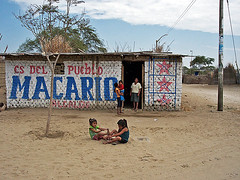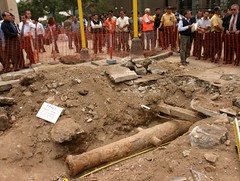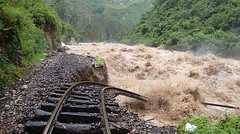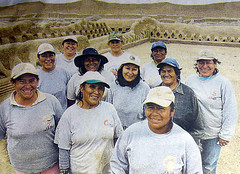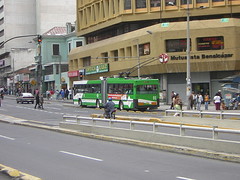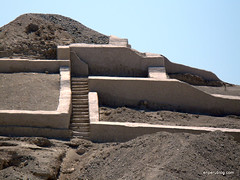Bon Appétit declares Lima “The Next Great Food City”

Peruvian Food
It had already been declared the gastronomic capital of the Americas and the home of one of the world’s twelve great cuisines. Now the city of Lima continues is rapid climb to the top of food-lover’s travel itineraries after gastronomy magazine Bon Appétit declared it their Destination of the Year 2009.
At the end of 2008 the magazine was quoted as saying about the city:
Want a new fusion cuisine sourced from the world’s best ingredients? Star chefs with personalities as big as their palates. A good exchange rate for the dollar? Welcome to Peru’s capital city, the next great global foodie destination.
It was last week, at the New York Times Travel Show, when the honour was made official. Mark Cooper, a representative of the prestigious magazine, presented the award to PromPeru representatives Maria Del Sol Velásquez and Amalia Melitti.
In the January 2009 edition it is written:
Want a new fusion cuisine sourced from the world’s best ingredients? Star chefs with personalities as big as their palates? A good exchange rate for the dollar? Welcome to Peru’s capital city, the next great global foodie destination.
It continues:
“JUST TRY TO IMAGINE ITALIAN FOOD WITHOUT TOMATOES, Mr. Duane. Or spanish cooking without chiles. Really, face it, my friend, the Inca domesticated fowl, so there would be no foie gras in France without the food of Peru.” Arturo Rubio’s voice begins to rise now, and he swings his soft hands around to illustrate his point—that every great culinary tradition on earth owes a debt to Peru. “No chocolate in Switzerland,” he cries, laughing at himself now. “No potatoes in Ireland.” Pausing to gulp a Peruvian beer, he nearly spits his next line with glee: “The Irish would’ve starved. New York would have no cops. My God, it was Portuguese traders who brought South American chiles to the Asian subcontinent; there would be no curry in India. No spices in Thailand!”
Worldly, portly, impeccably dressed in Paris-by-way-of-Oxford upscale casual, Rubio is both the owner of Restaurant Huaca Pucllana, which is located near a 1,500-year-old ruined pyramid in the Miraflores district of Lima, Peru, and the impassioned former president of the Committee for the Promotion of Peruvian Cuisine. Which explains not only his harangue but the four appetizers suddenly set down by his waiters: Italian-Peruvian grilled baby octopus with lima beans, Afro-Peruvian-Creole beef heart rubbed with dried chiles and then grilled, Japanese-Peruvian tiradito of raw sole marinated ceviche-style in lime juice and chiles, and Chinese-Peruvian lomo saltado.
Peru, Rubio now wants me to know, doesn’t just have great ingredients; it has one of the world’s great culinary fusions.
“Because you see, the first people who came to the New World from Spain were not only Catholic Castellanos,” Rubio says with the intensity of a scholar, “they were Spanish Jews and Muslims fleeing the Inquisition. So our gastronomy has Sephardic and Arabic Mediterranean roots. And then the European diseases wiped out all of the indigenous peoples in Peru, so the Spanish brought in West African slaves and put the women to work in plantation kitchens, and voilà! African Creole cooking becomes and remains the essential home cooking of Spanish-Indian Peru.”
And there was more: emancipation of those slaves leading to importation of Chinese indentured servants and, with them, Chinese culinary influences; Italian immigrants fleeing Garibaldi’s 1861 reunification of Italy; Japanese immigrants fleeing the shogun wars. “That was in the early 20th century,” Rubio tells me. “And was maybe the most important [event], for our gastronomy. You can see how it happens, all these Peru-born Japanese children begging Mommy to add maybe a little hot chile to the nightly sashimi so that it would taste like the food from those African-Creole street carts. And this is how you get what we Peruvians call the Nikkei style of restaurant. And you must know Nobu, yes? In New York? Well, Nobu worked in Peru.”
If Rubio sounds grandiose, forgive him, because Peru really is blessed with an almost ludicrous variety of natural resources, from the great seafood of the Pacific coast to the vegetables of the temperate highlands of the Andes to the wild tropical abundance of herbs and fish from the Amazon. And the country has one of the world’s most interesting natural culinary fusions, in evidence at high-profile places like Costanera 700 and Toshiro’s Sushi Bar, both innovators of Peruvian-Japanese fare, and at Chifa Kam Men, a notable Peruvian-Chinese restaurant. Perhaps most importantly, Peru is in the midst of a nationwide awakening about its own cuisine, driven in large part by Rubio and several of his contemporaries, including two others I’d come to see—Gastón Acurio and Pedro Miguel Schiaffino. All three of these men are well-educated children of privilege, Rubio and Acurio from political families, Schiaffino from a food manufacturing fortune. Acurio and Schiaffino trained in Michelin-starred European restaurants. All three want to bring the finest international techniques to their own great culinary patrimony, and then bring that to the wider world.
Gulping that Peruvian beer again (“All but the fruitiest of Alsatian Gewürztraminer would be overwhelmed by this ceviche”), Rubio puts it this way: “So, now that you know all this, tell me, where else do you go to eat in South America? Chile? No. They have far less produce, far less variety of gastronomy. Argentina? Great meat, yes. But no. So I’m telling you, Lima is now the gastronomic capital of South America.”
Read the rest here at bonappetit.com »
Tags: bon appetit, comida criolla, food, gaston acurio, lima, new york times



